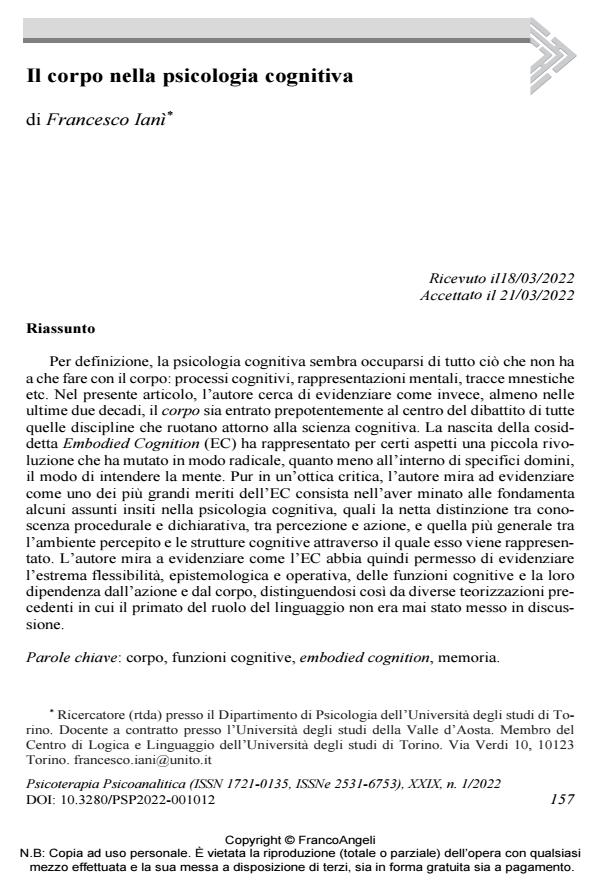The body in cognitive psychology
Journal title PSICOTERAPIA PSICOANALITICA
Author/s Francesco Ianì
Publishing Year 2022 Issue 2022/1
Language Italian Pages 16 P. 157-172 File size 233 KB
DOI 10.3280/PSP2022-001012
DOI is like a bar code for intellectual property: to have more infomation
click here
Below, you can see the article first page
If you want to buy this article in PDF format, you can do it, following the instructions to buy download credits

FrancoAngeli is member of Publishers International Linking Association, Inc (PILA), a not-for-profit association which run the CrossRef service enabling links to and from online scholarly content.
By definition, cognitive psychology seems to study something that has nothing to do with the body: cognitive processes, mental representations, memory traces etc. In this article, the author tries to highlight how instead, at least in the last two decades, the body has become central to the debate of all those disciplines around cognitive science. The birth of the so-called Embodied Cognition (EC) represented somehow a revolution that radically changed the way scholars study the mind, at least in certain domains. Even from a critical point of view, the author would like to emphasise that one of the greatest merits of EC is that it has undermined the foundations of some of the assumptions of cognitive psychology. For instance, EC has undermined the clear distinction between procedural and declarative knowledge, the distinction between perception and action, and, more generally, between the perceived environment and the cognitive structures by which it is represented. The author aims to show how EC has thus highlighted the extreme epistemological and operational flexibility of our cognitive functions and their dependence on action and the body, distinguishing itself from numerous previous theories in which the primacy of the role of language was never questioned.
Keywords: body, cognitive functions, embodied cognition, memory.
- Mind, Body, and Digital Brains Giulia Torromino, pp.173 (ISBN:978-3-031-58362-9)
- Peripheral transcutaneous electrical stimulation to improve cognition: a review of the main effects in healthy humans and in mildly cognitively impaired patient populations Giulia Fiorentini, Eva Massé, Stefania C. Ficarella, Giulia Torromino, in Progress in Neuro-Psychopharmacology and Biological Psychiatry 111290/2025 pp.111290
DOI: 10.1016/j.pnpbp.2025.111290
Francesco Ianì, Il corpo nella psicologia cognitiva in "PSICOTERAPIA PSICOANALITICA" 1/2022, pp 157-172, DOI: 10.3280/PSP2022-001012